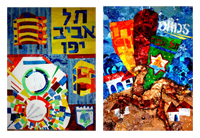Scrap Paper
Laurie Bellet
Almost every classroom I have ever been in has a box labeled ‘paper scraps.’ I have noticed, though, that the majority of these boxes have only a one-way door – papers go in but never go out!
In the Oakland Hebrew Day School Art Studio, we love our paper scraps boxes. We have one for colored paper, one for white paper and one for patterned papers. These scraps form the basis for some of our most impressive collaborative art works. Whether for a celebration like Yom ha-Atzma’ut or a special occasion like a visit from the mayor, our collaborative, sometimes whole school, collages make good use of our paper scraps.
For a large collage, I begin with a heavy (90lb), large piece of paper or poster board for the base. The first step is the most challenging – someone needs to draw the basic design. Collage work of this nature is imprecise so it is best to create a large design without small details. A quick internet search, using key words that describe your theme, will produce many options and ideas.
After I draw my design, I usually use colored pencils to shade each section as a guide when students are gluing their papers. We tend to prefer what we refer to as the “rip and rumple” technique. No scissors are involved and the piece takes on a terrific texture. When we use the scraps directly out of the box, the students glue the pieces themselves. You can use white glue or Mod Podge. Sometimes, though, we add to the experience and students add further texture to the paper with paints and all manner of painting tools. In this case, I generally place and glue the papers after they have dried.
When the collage gluing is done, the piece will look relatively good but it is not quite done. It helps to outline important areas with threads and yarns. Remnants will do very well at this stage. We always finish off our work with a thin coat of Mod Podge which eliminates any remaining scraggly look.
Because this kind of art piece is textured, it photographs and reproduces splendidly, providing opportunities to create greeting cards and other merchandise for future fundraising. These collages also bring a fine price at auction.
To make the best use of your paper scraps, students have to find the boxes inviting. There is, after all, no benefit to saving papers that students never use. All too often, every single paper scrap, useable and non-useable, gets swept into the box. We have a rule: if you would not want to use the scrap yourself, recycle it; do not put it into the box. Separating the colors and the whites also makes the paper scraps simpler to access. Having a rule that demands students never take a new, whole sheet of paper, when a scrap will do, makes the scraps box a ‘go to’ destination for many needs.
For more ideas on using odds, ends and leftovers, please visit Art at OHDS on Facebook or write to me at lbellet@ohds.org. (if you are in the SF Bay Area, please join us for the Oakland Hebrew Day School Art Show on May 25. You will find more ideas than you ever dreamed posssible!)
Conservation tip: save old copies and flyers and use these instead of clean copy paper whenever possible.



